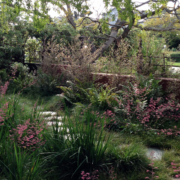Gardening Like A Wise Old OWL
Your landscaping soil needs three things to feed the billions of microbes within it that can transform brick-hard, lifeless dirt into healthy, living soil: Oxygen, Water, and Life. Or in shorthand: OWL.
Oxygen Lets Microbes Breathe Free
Oxygen is needed by plant roots and soil organisms. Healthy soil has lots of tiny pockets of air. When soils are eroded, graded, or disturbed, their structure becomes compacted and hard. Compaction takes place when air and water bubbles are squeezed out of the soil. This kills the healthy microbes that replenish soil. Microbes can be killed by fertilizers, pesticides, or even heavy traffic from people or vehicles.
Water For Your Microbes and Your Plants
Microbes and plants need water to live. But too much water in your soil will displace oxygen by saturating the soil. This creates an anaerobic condition — and unhealthy microbes like bacteria, viruses, or parasites prefer anaerobic soil. If this condition persists, diseases may develop that endanger the health of your garden.
Water is constantly moving through the soil. Water in the soil needs to be replenished as plants use it, as it evaporates from the soil surface, and as gravity pulls it down past the root zone of your plants.
Bring Your Soil To Life
Life in the soil includes all the bacteria, protozoa, nematodes, and fungi, the food they eat, the excretions they make, and the root systems they sustain. Living microbes are most quickly incorporated into your soil by adding high-quality compost.
Plants attract microbes to their roots by feeding them carbon. Bacteria and fungi hold the soil together with microscopic glues and binders. The microbes consume organic matter, and then they are consumed by bigger creatures (worms, ants, slugs, centipedes, larvae, etc.), which are consumed in turn by creatures further up the food chain.
Carbon and other nutrients cycle through these many life forms, creating healthy living soil, no matter what the soil type.
Without these three elements, landscaping will not thrive. Organic matter, planning and some labor may be involved, but creating healthy soil using the OWL method will pay off in reduced maintenance, reduced inputs, reduced pollution on land and in our waterways, and the beauty of your thriving, healthy landscape.
Get Your Free Sustainable Lanscapes Program Guidebook
This article was inspired by the 71-page Sustainable Landscapes Program guidebook available at SustainableLandscapesSD.org. Hardcopies are available free of charge at the Water Authority’s headquarters, 4677 Overland Ave., Kearny Mesa. The Water Authority and its partners also offer other great resources for landscaping upgrades, including free WaterSmart classes at WaterSmartSD.org.



